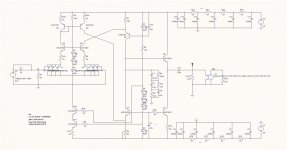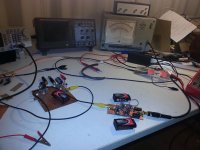I am about to test the noise in BJT transistors suitable for MC duty.
Of cause i have my favourites but some new types have being comming in.
I can not afford a QuanTec analyser so i build my own little noise test rig.
I have finished the build but i have not tested it.
It is a rather simple ca. 80dB gain amp with 1nV/qHz noise.
Bandwidth is 20Hz to 20Khz ( ca. -3dB ).
It runs on batteries for cleanest results.
The DUTs are arranged in a simple Curl style pre-pre so i test NPN and PNP at ones.
I will measure the noise with my Sennheiser Tube Millivolt Meter.
Of cause i have my favourites but some new types have being comming in.
I can not afford a QuanTec analyser so i build my own little noise test rig.
I have finished the build but i have not tested it.
It is a rather simple ca. 80dB gain amp with 1nV/qHz noise.
Bandwidth is 20Hz to 20Khz ( ca. -3dB ).
It runs on batteries for cleanest results.
The DUTs are arranged in a simple Curl style pre-pre so i test NPN and PNP at ones.
I will measure the noise with my Sennheiser Tube Millivolt Meter.
There are interesting elements in the circuit so i posted it.
Electrocompaniet made many things different in the old times.
I watch it out of historical reasons.
It was not a critique, just my opinion of the circuit (as you know)
It was not a critique, just my opinion of the circuit (as you know)for it's time a good, and as you say, interesting circuit, and also I circuit to learn from.
What is special about this circuit in post 10176
http://www.diyaudio.com/forums/analogue-source/154210-mpp-1018.html#post4045381
apart from the fact that they transformed what is apparently a power amp
standard diagram for prepre use? It has four gain stages at a gain of just
about 15, is dc coupled without servo or offset adjustment which is a threat
to the pickup in this feedback configuration and it is inverting.
What you can learn is to do it better.
This circuit is at least 30 years old.
It is not " good " in any way.
The input transistors are very low noise and they go inverted.
That they did in the power amps too.
I find it kind of interesting that it is two long tail pairs of the same gender but fed from undependent current sources.
They fold one over, but not very symmetrical.
It is not " good " in any way.
The input transistors are very low noise and they go inverted.
That they did in the power amps too.
I find it kind of interesting that it is two long tail pairs of the same gender but fed from undependent current sources.
They fold one over, but not very symmetrical.
Last edited:
"Old" does not mean bad. You can find better examples, 40+ years old.
They don't fold it but invert it by a unity gain inverter.
This is indeed "unique"..
Sorry for being sceptical at EC, I had plenty of them in my workshop for repair.
They fold one over, but not very symmetrical.
They don't fold it but invert it by a unity gain inverter.
This is indeed "unique"..
Sorry for being sceptical at EC, I had plenty of them in my workshop for repair.
The use of independent current sources does not change the operation.I find it kind of interesting that it is two long tail pairs of the same gender but fed from undependent current sources.
Here is a picture of the setup.
At the input of the MC pre-pre you can put in resistors as noise refference.
It is a short, 6 Ohm, 15 Ohm and 47 Ohm.
The reading i get with the test circuit is 18.5mV into the Sennheiser Tube Millivolt Meter on a 30mV scale.
You that does translate into input noise i explain later.
At the input of the MC pre-pre you can put in resistors as noise refference.
It is a short, 6 Ohm, 15 Ohm and 47 Ohm.
The reading i get with the test circuit is 18.5mV into the Sennheiser Tube Millivolt Meter on a 30mV scale.
You that does translate into input noise i explain later.
Attachments
Here is a picture of the setup.
At the input of the MC pre-pre you can put in resistors as noise refference.
It is a short, 6 Ohm, 15 Ohm and 47 Ohm.
The reading i get with the test circuit is 18.5mV into the Sennheiser Tube Millivolt Meter on a 30mV scale.
You that does translate into input noise i explain later.
Where did you find that desk space? yesterday it was not there
And i build really fast when i do not have visitors......
Wir kommen nicht wieder ..
Look at this animals :http://diodes.com/datasheets/ZXTN19020DG.pdf
They can cary a truck load of current.
The only limit is the low Vce.
An MC pre-pre does not need high voltage parts though.
Awesome Hfe.
They can cary a truck load of current.
The only limit is the low Vce.
An MC pre-pre does not need high voltage parts though.
Awesome Hfe.
Last edited:

